|

Bastille 1370-1789
The word bastille derives from bastion, Latin
for fortress, tower.
|
|
Hence, bastille,
also spelled bastile, can refer to any
small fortress.
Image Above
La Bastille
Color Print from
ca. 1889
Musée national des
Arts et Traditions Populaires |
However, the Bastille was a fortress in
Paris located at the St Antoine gate. It was also used as an arsenal and a prison.
Thus, by extension, the word bastille can sometimes
also refer to a prison.
About the
Bastille in Paris
The Bastille had
eight towers, which were 73 feet high and six feet thick. It
was armed with 15
cannons, and connected with walls that
were 10 feet wide.
A 25 ft deep moat surrounded the
Bastille. The moat was dry, except during floods of the Seine.
Here she stands:

The Bastille
Next to the St Antoine Gate,
Paris
Wiki
Here is the map:
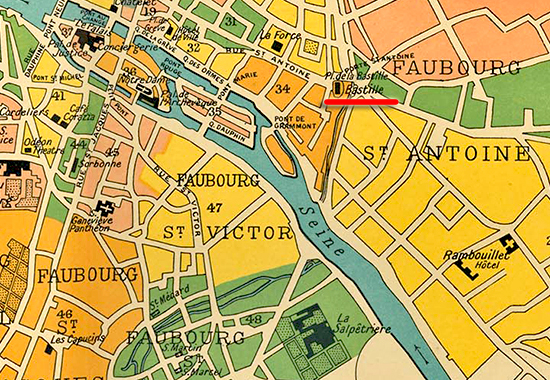
Map Location of the Bastille - Paris
1789
Map of Paris in
1789. Click to
enlarge
And here is the floor plan:

Layout of the
Bastille in 1789 (after Pierre-François Palloy)
The Towers of the Bastille
Each tower had its name. The
Chapel Tower and the
Treasury Tower were built first. Soon
after, the Liberty Tower and the
Bertaudière Tower were
built. Then added were the Corner Tower and the
Well Tower,
and lastly the County Tower and the
Basinière Tower.
Although the same height, the
towers of the Bastille did not have the same number of
floors. Treasury and Chapel had only two floors and no
dungeons, whereas Liberty and Bertaudière had three floors
and dungeons. The four corner towers, Corner, Well, County,
and Basinière, had five floors of jail cells.
Here is more on the towers, and
the legend of the layout of the Bastille above:
1
Corner Tower.
Obviously, this tower received its name from
its location at the corner of rue
Saint-Antoine.
2
Chapel Tower.
In the fifteenth century, the chapel of the
Bastille was set up in this tower. It was
afterwards transferred to a spot between Liberty
Tower and Bertaudière Tower.
3
Treasury Tower, so named when
 Henry
IV stored his savings
here in order to create a state treasury.
Outside, between Chapel and Treasury Tower,
was still visible the arch that was the
first gate of Saint-Antoine. Henry
IV stored his savings
here in order to create a state treasury.
Outside, between Chapel and Treasury Tower,
was still visible the arch that was the
first gate of Saint-Antoine.
4
County Tower.
The origin of the name of this tower is
unknown.
5
Well Tower.
The well of the Bastille had been dug at the
foot of this tower.
6
Liberty
Tower. The name of this tower was given in a slightly
sarcastic spirit around 1380, when the
Parisians demanded freedom and at the same
time the provost of Paris,
Hugues Aubriot,
was locked up. At the floor of this tower
was the interrogation room, which might or
might not have ceased to be used as such when
 Louis
XVI officially abolished torture. Louis
XVI officially abolished torture.
7
Bertaudière Tower.
This tower was named after the mason Bertaudière,
who was killed falling from the platform
during construction. Its third floor was
used as the prison for the
Man in the Iron
Mask.
8
Basinière Tower.
This tower was named after a prisoner that was locked up here in 1663, a
Sir de la Basinière,
who was Treasurer of Savings.
9 Council
Chamber. 10 Library.
11 Chapel.
12 Archives.
13 Guard.
14 Old city gate.
15 Door from the bastion.
16 Drawbridge to the entrance.
17
Court of the well.
18 Large yard.
The Chapel, Treasury, Liberty, Bertaudière,
County, and Basinière Tower led to a
courtyard 120 feet long and 72 feet wide.
19 Kitchens.
20 Court government.
21 Housing
of the governor.
22 Trail round.
23 Bastion and garden.
24 Gateway of the
passage. 25 Invalids under the armory.
26 Door to the
elm courtyard.
27 Special shops.
28 Stables and outbuildings.
29 Advanced drawbridge.
30
The garden gate of the arsenal.
31 Terrace and promenade.
32
Guard of advance.
33 Belvédère and parlor.
34 Moat staircase outside.
35
Moat staircase inside.
36 Dungeon.
When and Why Was the
Bastille Built?
Building of the Bastille
commenced on April 22, 1370, under
 Charles V in order to
protect against the English (see also the
Charles V in order to
protect against the English (see also the
 Hundred Years' War).
Provost of Paris at the time was
Hugues Aubriot.
Hundred Years' War).
Provost of Paris at the time was
Hugues Aubriot.
The Bastille was
completed in 1383 under Charles VI,
who could be sane at times.

Bastille Map
Location Rue Saint-Antoine Paris
From Turgot's Paris
1739
Illustrating: Rue de la Contrescarpe, Petit Arcenal, Porte St Antoine, Rue du
Rempart, Rue Jean Beau-sire, Rue des Tournelles,
Ste Marie,
H. de Maienne
Fortress and
Prison
During the 16th and the 17th
century, the Bastille was expanded. The Bastille had been
occasionally used as a prison from the beginning. It was
transformed into a state prison in 1417.
The Bastille became a fortress
of great importance. Under
 Louis XI, who lived 1423-1483, the Bastille was
considered to be the key to the capital. All eight towers were
complete in 1553.
Louis XI, who lived 1423-1483, the Bastille was
considered to be the key to the capital. All eight towers were
complete in 1553.
Later, when the faubourg
or suburb of Saint-Antoine was built, the Bastille was
surrounded by houses and completely lost its military value.
It henceforth became Paris' most fortified arsenal and
prison, which meant that at this point the citizens grew to
fear and hate the Bastille as a constant reminder of a
threat to their liberties. Most notorious were the
underground dungeons that were basically graves only with a
tad more oxygen.
The Bastille was fully converted
into a prison during the seventeenth century, and especially with
 Richelieu, who lived
1585-1642, it was in regular use. Richelieu, who lived
1585-1642, it was in regular use.
Under
 Louis XIV, who ruled
1643-1715, the Bastille prison
cells were in good demand. Protestants,
followers of Cornelius Otto Jansen,
spies, unwanted nobles, bourgeois, merchants, assassins,
thieves, magicians, booksellers, peddlers, men of letters,
anyone accused of treason or lese-majesty (any offence
against the sovereign authority) and other culprits whose public
prosecution might have triggered too many raised eyebrows, populated the Bastille.
Louis XIV, who ruled
1643-1715, the Bastille prison
cells were in good demand. Protestants,
followers of Cornelius Otto Jansen,
spies, unwanted nobles, bourgeois, merchants, assassins,
thieves, magicians, booksellers, peddlers, men of letters,
anyone accused of treason or lese-majesty (any offence
against the sovereign authority) and other culprits whose public
prosecution might have triggered too many raised eyebrows, populated the Bastille.
During the second
half of Louis XIV's reign, quite a few people ended up in
the Bastille without having done anything.
All that was
needed to put your enemy or relative of choice away — for a limited time
or forever — was a
Lettre de Cachet, a Letter of Seal, which was a
document with the king's signature, co-signed by a
Secretary of State, and
made official by the royal seal.
Under Louis XIV, more than
80,000 lettres de cachet were signed. This document was a final verdict
without the option of an appeal. No trial, no hearing, no
questions asked. Welcome to royal absolutism.
See also
 French Revolution Glossary: Lettre de
Cachet
French Revolution Glossary: Lettre de
Cachet
Famous Prisoners
of the Bastille
|
Famous prisoner in 1717 was
 Voltaire (picture
right,)
Voltaire (picture
right,)
who
had made fun of Philippe II, the duke d'Orléans,
and
who was consequently given
solitary time to re-think his mockery. |
 |
In 1741, the Bastille housed 71
prisoners. In 1755, it were 50.
Under
 Louis XVI, the last
king before the
Louis XVI, the last
king before the
 Revolution, the Bastille
booked less traffic. The annual admission was approx. 16 new prisoners, many of
which didn't stay for long.
Revolution, the Bastille
booked less traffic. The annual admission was approx. 16 new prisoners, many of
which didn't stay for long.
 |
One of the last prisoners at the
Bastille was the
 Marquis de Sade
(picture left,) who
stayed at this address from 1784 to 1789. Marquis de Sade
(picture left,) who
stayed at this address from 1784 to 1789.
De Sade was
transferred away ten days before all hell broke loose.
|

Fall of the
Bastille July 14, 1789
Collection De Vinck / BnFs
Storming of the
Bastille on July 14, 1789
Generally feared, the Bastille was a
symbol of royal tyranny and arbitrary rule.
Already on the night of June 30,
1789, there was some talk of seizing this fortress. Now,
word had spread that on the night of July 12, 1789,
ammunition had been transferred to the
Bastille.
On the evening of July 13, 1789,
some shots were being exchanged between the mob and the
guards of the Bastille.
The Bastille was stormed by the
revolutionaries on July 14, 1789.
Defending the Bastille were 32
Swiss and 82 Invalides (pensioners,) all in all a garrison
of 114 men. Led, of course, by the prison governor,
Bernard Jordan de Launay,
whose head was going to be on a pike later that day, the
first of many more to come during the course of the
 French Revolution.
French Revolution.
On that day, July 14, 1789, only seven
prisoners were held at the Bastille, four of which for
counterfeiting, and one completely nuts.

Storm of the
Bastille — July 14, 1789
Painting by Unknown Artist ©
Réunion des musées nationaux
The Fall of the Bastille marked the beginning of the
 French Revolution.
French Revolution.
The upkeep of the Bastille had been expensive. This fact and the recent
revolutionary events made the monarchy decide
to tear down the entire structure.
Dismantling of the Bastille commenced
immediately and was entrusted to the contractor
Pierre-François Palloy. Many volunteers pitched
in enthusiastically and the Bastille was completely bulldozed by 1790.
Hubert Robert
sketched a painting of the
Destruction of the Bastille, dramatically drawing the Bastille much
larger than it actually was, which, in turn, gave its demolition much
more significance. See his painting in the right column.
As in the case of the Fall of the
 Berlin Wall, many souvenirs
were taken from the Bastille. Pieces of brick were sent all across
the country, triggering much patriotic happiness wherever they were
received.
Berlin Wall, many souvenirs
were taken from the Bastille. Pieces of brick were sent all across
the country, triggering much patriotic happiness wherever they were
received.
In summary, if you are planning a visit to
the ruins of the Bastille, don't. They don't exist.
The
Bastille Today
What's left of the Bastille is the
outline of the structure, marked in the pavement. Here is a photo of
the corner Rue
Saint-Antoine / Boulevard Beaumarchais.

Outline of the
Bastille in the Pavement at the
corner of Rue Saint-Antoine and Place de la Bastille
Photo: Tangopaso / Wiki
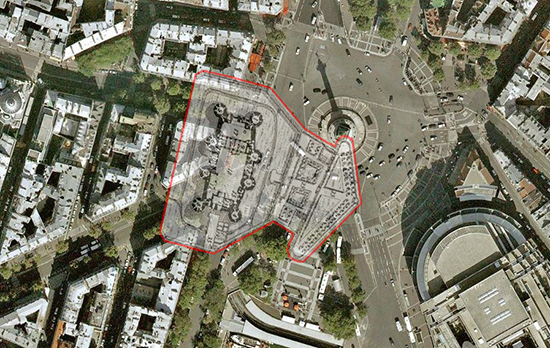
Outline of the
Bastille Over Google Satellite Map
Just to give us an idea. Own
work, so let's not get excited.
In 1899, during construction work for
the Metro, some remains of the Liberty Tower were found and brought to the park just down the road on
Boulevard Henry IV.
Here they are:

Remains of the
Bastille — What's Left of the Tower of Liberty
Photo: FLLL / Wiki
And just in case you were wondering,
the plaque reads:

"Vestiges des fondations
de la Bastille
Tour de la Liberté
découverts en 1899
et transportés sur cet emplacement
In other words,
Vestiges of the foundations of the
Bastille Liberty Tower
Discovered in 1899 and brought here
The
Place de la Bastille
In 1793, the Bastille square was
adorned with a fountain.
Later,
 Napoleon decided that something
a little bit more monumental should be erected there in order to commemorate the anniversary of his coming to power.
Hence, from 1814 to 1846, the center of the
Place de la Bastille was occupied by a gigantic plaster elephant
fountain. The idea was to replace it with a bronze elephant, but after Napoleon's defeat the
project was not followed through.
Napoleon decided that something
a little bit more monumental should be erected there in order to commemorate the anniversary of his coming to power.
Hence, from 1814 to 1846, the center of the
Place de la Bastille was occupied by a gigantic plaster elephant
fountain. The idea was to replace it with a bronze elephant, but after Napoleon's defeat the
project was not followed through.
After the Revolution of 1830,
the entire elephant project was completely canceled in favor of the
July
Column.

Postcard from
1906-1924: Paris — La Place de la Bastille
With the July Column, or Colonne de Juillet
Ministère de la culture
The above July Column
still stands today in the center of the Place de la Bastille.
It
commemorates the Revolution of 1830, not the
 Revolution of 1789.
Revolution of 1789.
By the way, the water that runs
underneath the Place de la Bastille is the
Saint-Martin Canal.
Celebrating July 14
The commemoration of July 14, 1789,
was abandoned until the Third Republic,
spearheaded by
Gambetta, sought to celebrate the
foundation of the regime.
Since 1880, July 14 is
Bastille Day, but officially called the
Quatorze
Juillet, or Fourteenth of July.
It is a national holiday in France with military parades, fireworks,
dance, live music, food,
and whatever else entertainment the French soul can come up with. The
festival begins on the evening of July 13 with a torchlight procession.
Hence, from a symbol of repression the
Bastille became a symbol of liberty.
To be technically correct, the July 14
festivities commemorate the Fête de la Fédération or
Celebration (Festival) of the Federation of July 14, 1790, the first
anniversary of the Storm of the Bastille.
See also
 Lafayette.
Lafayette.

July 14, 1790:
100,000 Parisians at the Champ-de-Mars for the
Festival of the
Federation
Présidence de la République
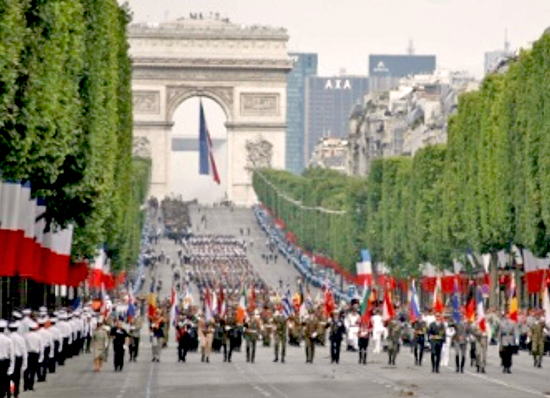
July 14 in France
Présidence de la République
And here are some
shots from the July, 2011 parade:

Parade July 14,
2011, Paris: The President of the Republic and
the Chief of Staff of the Army on board the command car.
© ECPAD

Parade July 14, 2011,
Paris:
L'école militaire interarmes (EMIA) &
L'école militaire du corps technique et administratif (EMCTA)
© ECPAD
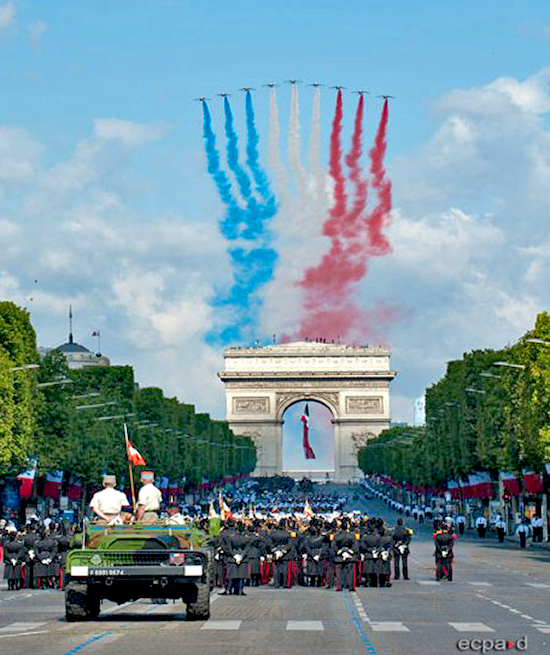
Parade July 14, 2011,
Paris: The Patrouille of the French Air Force
© ECPAD
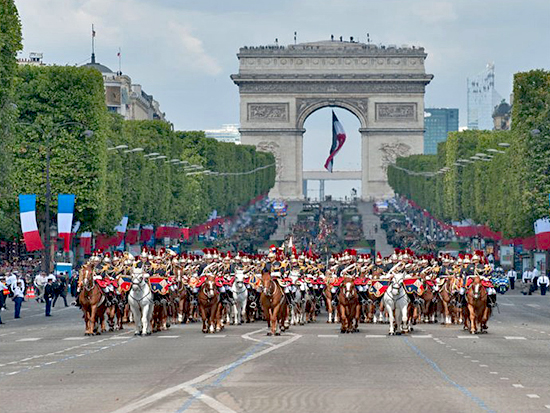
Parade July 14, 2011,
Paris: French Cavalry
© ECPAD
More History
|